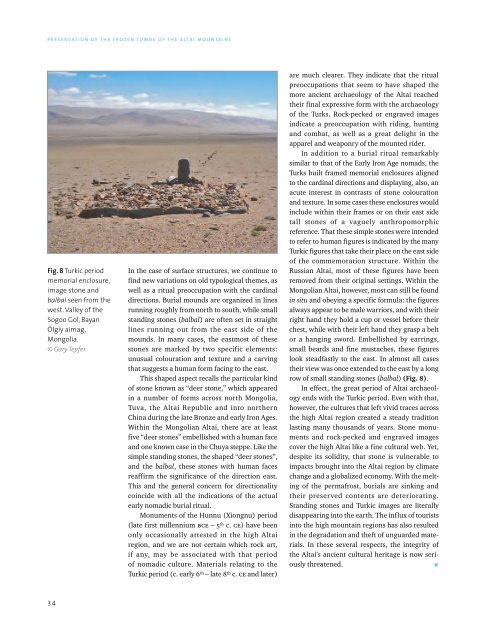Scythian Culture - Preservation of The Frozen Tombs of The Altai Mountains (UNESCO)
Create successful ePaper yourself
Turn your PDF publications into a flip-book with our unique Google optimized e-Paper software.
PRESERVATION OF THE FROZEN TOMBS OF THE ALTAI MOUNTAINS<br />
Fig. 8 Turkic period<br />
memorial enclosure,<br />
image stone and<br />
balbal seen from the<br />
west. Valley <strong>of</strong> the<br />
Sogoo Gol, Bayan<br />
Ölgiy aimag,<br />
Mongolia.<br />
© Gary Tepfer.<br />
In the case <strong>of</strong> surface structures, we continue to<br />
find new variations on old typological themes, as<br />
well as a ritual preoccupation with the cardinal<br />
directions. Burial mounds are organized in lines<br />
running roughly from north to south, while small<br />
standing stones (balbal) are <strong>of</strong>ten set in straight<br />
lines running out from the east side <strong>of</strong> the<br />
mounds. In many cases, the eastmost <strong>of</strong> these<br />
stones are marked by two specific elements:<br />
unusual colouration and texture and a carving<br />
that suggests a human form facing to the east.<br />
This shaped aspect recalls the particular kind<br />
<strong>of</strong> stone known as “deer stone,” which appeared<br />
in a number <strong>of</strong> forms across north Mongolia,<br />
Tuva, the <strong>Altai</strong> Republic and into northern<br />
China during the late Bronze and early Iron Ages.<br />
Within the Mongolian <strong>Altai</strong>, there are at least<br />
five “deer stones” embellished with a human face<br />
and one known case in the Chuya steppe. Like the<br />
simple standing stones, the shaped “deer stones”,<br />
and the balbal, these stones with human faces<br />
reaffirm the significance <strong>of</strong> the direction east.<br />
This and the general concern for directionality<br />
coincide with all the indications <strong>of</strong> the actual<br />
early nomadic burial ritual.<br />
Monuments <strong>of</strong> the Hunnu (Xiongnu) period<br />
(late first millennium bce – 5 th c. ce) have been<br />
only occasionally attested in the high <strong>Altai</strong><br />
region, and we are not certain which rock art,<br />
if any, may be associated with that period<br />
<strong>of</strong> nomadic culture. Materials relating to the<br />
Turkic period (c. early 6 th – late 8 th c. ce and later)<br />
are much clearer. <strong>The</strong>y indicate that the ritual<br />
preoccupations that seem to have shaped the<br />
more ancient archaeology <strong>of</strong> the <strong>Altai</strong> reached<br />
their final expressive form with the archaeology<br />
<strong>of</strong> the Turks. Rock-pecked or engraved images<br />
indicate a preoccupation with riding, hunting<br />
and combat, as well as a great delight in the<br />
apparel and weaponry <strong>of</strong> the mounted rider.<br />
In addition to a burial ritual remarkably<br />
similar to that <strong>of</strong> the Early Iron Age nomads, the<br />
Turks built framed memorial enclosures aligned<br />
to the cardinal directions and displaying, also, an<br />
acute interest in contrasts <strong>of</strong> stone colouration<br />
and texture. In some cases these enclosures would<br />
include within their frames or on their east side<br />
tall stones <strong>of</strong> a vaguely anthropomorphic<br />
reference. That these simple stones were intended<br />
to refer to human figures is indicated by the many<br />
Turkic figures that take their place on the east side<br />
<strong>of</strong> the commemoration structure. Within the<br />
Russian <strong>Altai</strong>, most <strong>of</strong> these figures have been<br />
removed from their original settings. Within the<br />
Mongolian <strong>Altai</strong>, however, most can still be found<br />
in situ and obeying a specific formula: the figures<br />
always appear to be male warriors, and with their<br />
right hand they hold a cup or vessel before their<br />
chest, while with their left hand they grasp a belt<br />
or a hanging sword. Embellished by earrings,<br />
small beards and fine mustaches, these figures<br />
look steadfastly to the east. In almost all cases<br />
their view was once extended to the east by a long<br />
row <strong>of</strong> small standing stones (balbal) (Fig. 8).<br />
In effect, the great period <strong>of</strong> <strong>Altai</strong> archaeology<br />
ends with the Turkic period. Even with that,<br />
however, the cultures that left vivid traces across<br />
the high <strong>Altai</strong> region created a steady tradition<br />
lasting many thousands <strong>of</strong> years. Stone monuments<br />
and rock-pecked and engraved images<br />
cover the high <strong>Altai</strong> like a fine cultural web. Yet,<br />
despite its solidity, that stone is vulnerable to<br />
impacts brought into the <strong>Altai</strong> region by climate<br />
change and a globalized economy. With the melting<br />
<strong>of</strong> the permafrost, burials are sinking and<br />
their preserved contents are deteriorating.<br />
Standing stones and Turkic images are literally<br />
disappearing into the earth. <strong>The</strong> influx <strong>of</strong> tourists<br />
into the high mountain regions has also resulted<br />
in the degradation and theft <strong>of</strong> unguarded materials.<br />
In these several respects, the integrity <strong>of</strong><br />
the <strong>Altai</strong>’s ancient cultural heritage is now seriously<br />
threatened.<br />
34
















